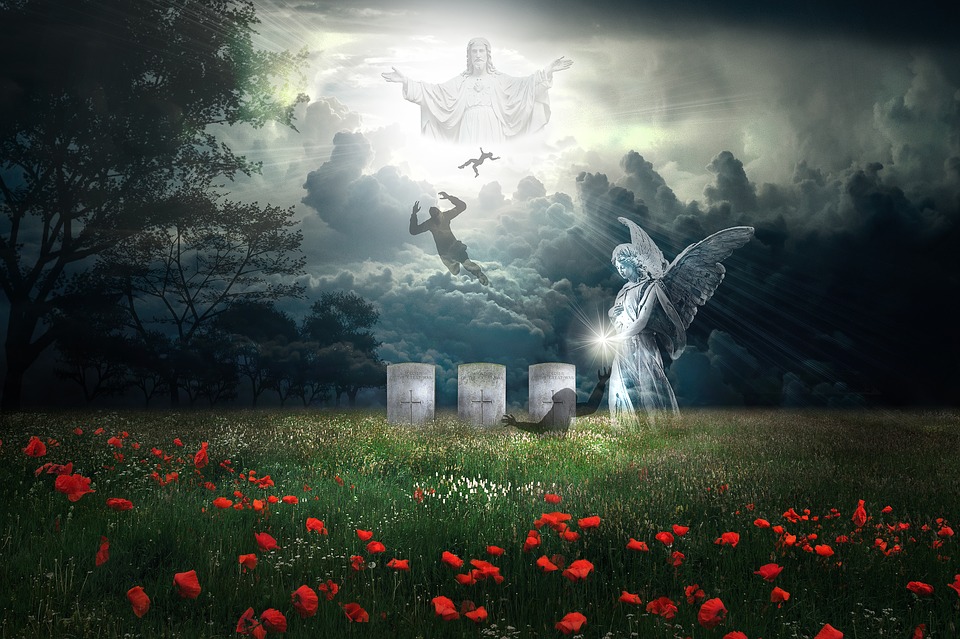In my latest look at the once great British Comic scene I revisit an old article originally published on the Comic Conversations site.
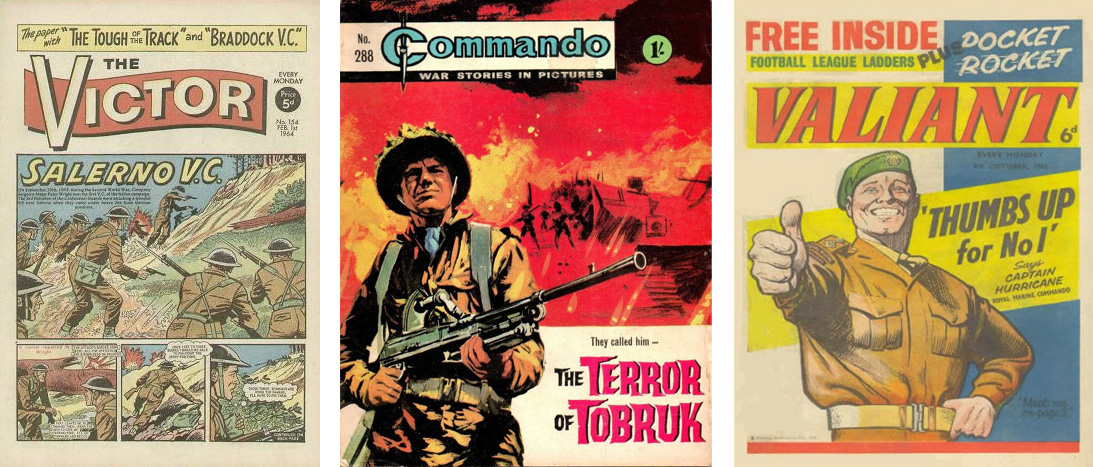
Although they are written in the same language there has always been massive differences between British and American comics. The format, artwork, tone, style and content have at times shared little in common and this has been evident in the genres that have worked and failed on the two continents. Superheroes though massive in America struggled to find a place in the UK’s homegrown market and conversely as the comic code authority diluted and ran off the America war comics, over in the UK it was stories set in the First and Second World Wars which were for a time the most popular to feature on comic shelves.
War comics thrived for decades in the UK and their development at times paralleled with the changes in the whole industry.
For many years daring to read comics above the age of twelve in the UK would make you the target of ridicule and derision. Yet there was one long running series that you could openly read without the shame akin to being caught with a porn mag. In 1961 DC Thompson began publishing Commando, a war comic in a tantalisingly collectable 7 × 5½ inch, 68 page format that has since gone on to become a British Institution.

Mention Commando to most British males and you’ll invariably be rewarded with an expression of pure joy, as a nostalgic wave of memories for such titles as “Take No Prisoners” “Hounds of War” “Marauder Squadron” and the decidedly racist “Scourge of the Japs,” and “Jap Killer.” And then there were those wonderfully lurid pulp style covers that in a country that didn’t have a comics code authority to interfere would often show acts of violence such as “Knife for a Nazi” depicting a close up of a German about to have his throat cut and “Kill or Be Killed” catching two soldiers in a bitter Knife fight to the death.


The stories themselves were very much of the boys adventure variety. Full of action and with a fair share of patriotism and stereotyping, they were many times morality tales as familiar themes would crop up time and again over the series. Many times we followed the adventures of a young solider or pilot having to fight his own fears or lack of confidence in order to prove his manhood and earn acceptance by his comrades. Or brave soldiers having to overcome the cowardice and incompetence of senior officers.
The plots may have been simple but I loved them as a kid and accidentally learned a bit of history along the way. Historically and technically the creators tried to be as accurate as possible even if the stories often were not realistic. I remember even as a child laughing at one panel where a British Solider in the jungle triggered a tripwire and as Japanese troops surrounded him cried out “Crikey!” in a moment of pure Englishness. The language and dialogue was often ripe for parody in Commando drawing on the style of the Biggles novels with such cries as “Achtung Tommy” “Take that Fritz” or “Ginger’s bought it!” common place.
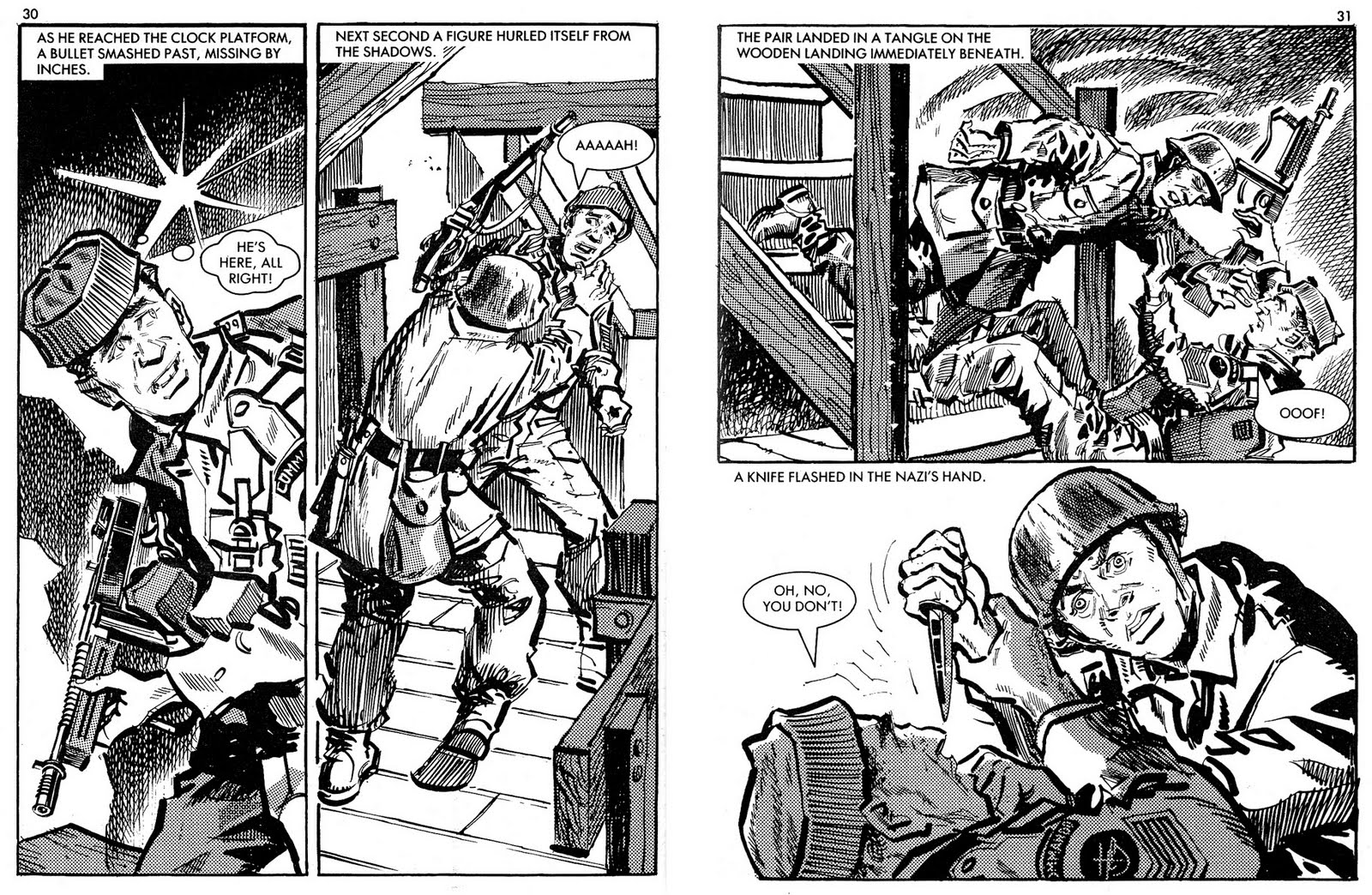
While most of the stories focused on World Wars One and Two other conflicts would occasionally be covered, even sometimes featuring modern conflicts such as Vietnam and the Falklands and stories set in Ancient and Medieval times. Although the emphasis was normally on British or allied troops a few issues also told stories from the side of the German army.

Like many boys my age I had stacks of Commando comics, their spine format made them easier to store and keep in decent condition and were less likely to be thrown out by your mum for cluttering up your bedroom. Because of this if you go to any charity shop or car boot sale and it’s the comic you’re most likely to be able to pick up (especially if someone with a good collection has recently died. It’s sad but true and I have to admit I long for the day I visit a Help the Aged store just as a child of the seventies has passed away and their unknowing family have donated their prized collection of “Action” comics. All is fair in comic collecting people).
Commando is still running today and ironically printing recently relocated to Germany. To date there have been 4742 issues of Commando and to my surprise new stories are still being published (currently eight issues are published a month half being reprints of earlier titles).
Although the name Commando has entered the public consciousness, it was in fact a direct copy of another series by rival publisher IPC called War Picture Library which ran from 1958 to 1984 (for what it’s worth I remember preferring War Picture Library to Commando though I can’t really remember why). Commando became a more successful comic to the extent that people would refer to WPL as a Commando comic. However IPC would enjoy it’s own success when it returned the favour by copying it’s rival’s weekly 1974 war comic Warlord.


That comic was Battle (originally Battle picture weekly) a weekly anthology comic which was launched in March 1975 and with it’s first issue came a free gift in the form of a set of stickers based on World War II badges. Battle and Warlord (which although less popular still ran for twelve years) were a massive step away from the tone of Commando, delighting young readers with an edgy, darker violent seventies style.
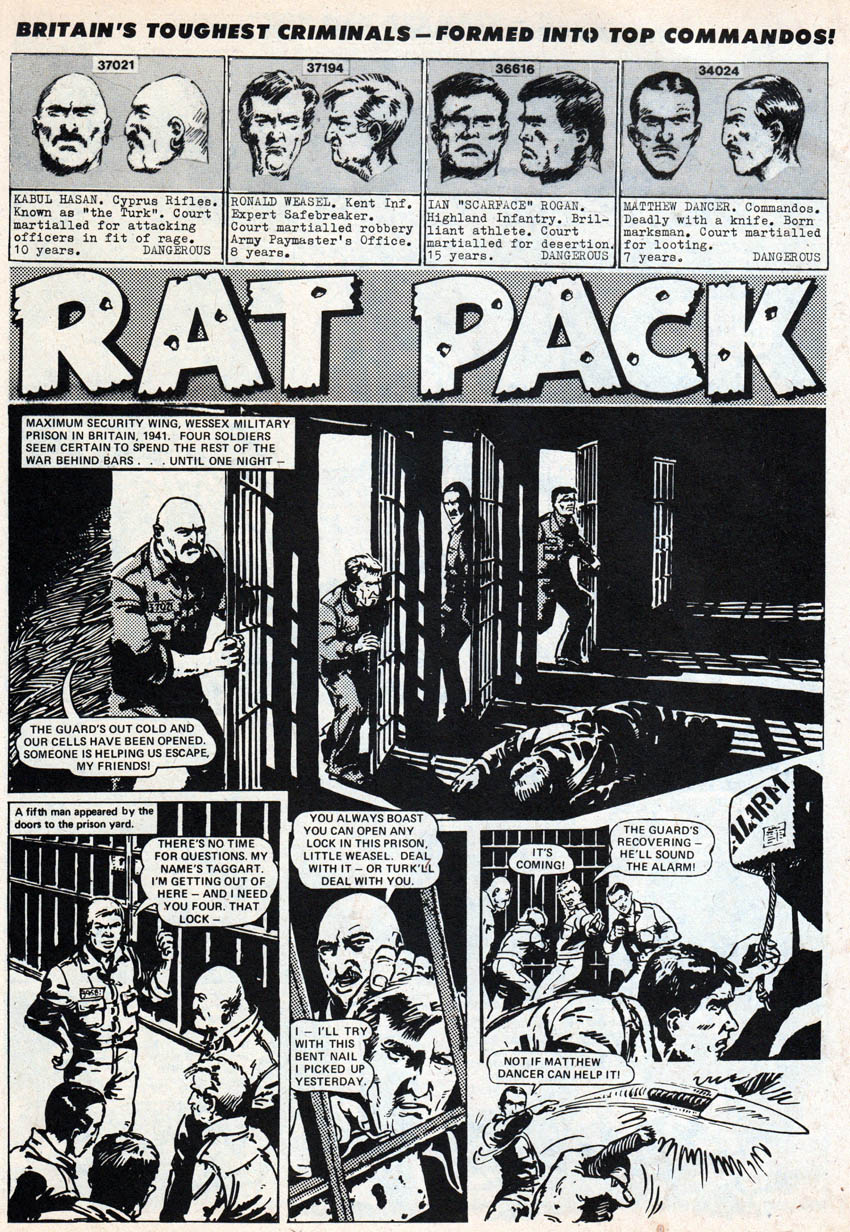
If Commando was full of public school dashing, daring adventures Battle was more of a modern working class edge, full of snarling anti heroes who didn’t hold back on the violence and gore. Ratpack for example was a dirty dozen style team series of criminals being sent on suicide missions, Terror behind the Bamboo Curtain a short lived series that dealt with a British soldier’s battles with a sadistic ruler of a Japanese prisoner of war camp and Darkie’s mob which featured a guerilla squad behind Japanese lines led by a grim renegade Captain fighting his own private war. Darkie’s mob would heavily influence Bad Company in 2000AD many years later. In fact in many ways Battle paved the way for the violence and dirty, gritty feel that would be the hallmark of 2000AD and it’s most popular stories featured the anti heroes mould that it’s science fiction stable mate was built around. Certainly it brought together the team of Pat Mills, John Wagner and Carlos Ezquerra.

My personal favourites were Johnny Red which was an incredible story arc about a disgraced RAF pilot who finds himself fighting the Nazi’s as a member of the rough, viking like Russian airforce. There was also The Sarge following a John Wayne like figure and his platoon making their way through the second world war. Each member of the platoon you got to know through the nicknames and personality traits that stayed just short of becoming gimmicks but made each memorable. There was the miserable loner “Unknown solider” pretty boy “Handsome Carter” short guy “Beetle Baily”, the bickering “Laurel and Hardy”, “Frank the Yank” a half Brit half American who wanted to transfer to the American Army. You get the picture.
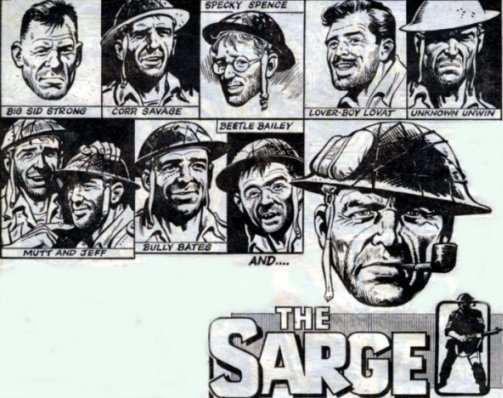
Readers really got themselves attached to these characters at their peril as the death rate in this platoon was high (the mortality of characters was another way that British and American comics differed as British comics would not shy away from killing off all but it’s top stars). Anytime a member took centre stage in a story you worried for their well being as this was often a sign they were getting buried by the end of the story. I’ll never forget the lump in my throat when Speccy (so called because he wore glasses) wandered blindly into the path of a sniper and was killed. (One week my local newsagent messed up and I missed an issue of Battle. When normal service resumed I found to my shock that four regulars had been slaughtered in that missing issue).
However the major achievement that Battle will rightfully be remembered for is one of the greatest comics the UK has ever produced, in fact arguably one of the greatest comic strips of all time, Pat Mill’s “Charley’s War”.
Charley’s War is simply brillant.

It’s a strip that has gained rightful acclaim as not only a great comic but an important piece of literature, an accolade normally reserved for strips created for the graphic novel format such as Persepolis and Maus and not normally the pulp pages of a weekly like Battle.
Set in the First World War it follows the experiences of Charlie Bourne who seeking excitement and adventure falls for the patriotic fervour of recruiters and lies about his age so he can enlist and serve in the war. Through him we see the brutality and horror of daily life in the trenches, illustrated with fine work by Joe Colquhoun. It’s full of action, but it’s so grim and vicious that it resembles the tone of Saving Private Ryan where an impending battle is cause for dread rather than excitement.

Nothing is held back in scenes that were way ahead of their time with a challenging level of maturity for what were still considered children’s comics. At one point Charlie is punished for refusing to take part in a firing squad to execute a comrade accused of cowardice. Later another comrade is burnt alive by German Flamethrower attack and has to be put out of his misery with a bullet. Even the enemy are treated with sympathy. When Charlie discovers a dead German solider he remarks that he looks as young as him. Likewise there is incompetence and sadism from within the British ranks, nowhere is this embodied more than in the strip’s main villain Snell, an upperclass officer who revels in the conflict and cares little for the men under his charge.
One of the scenes that always stays with me is when he forces captured civilians into a cellar and then as he closes the door drops a grenade onto them. Throughout the series Snell orders his platoon into dangerous situations just to feed his own lust for glory, even ordering one final charge against the enemy with only seconds before the war is due to end at 11am and most of the squad are needlessly massacred (Incidentally how many people do you think lose their lives by setting a time for when hostilities are meant to end instead of just stopping fighting there and then? Pretty much tells you how fucked up the whole business of war really is!)

Charley’s War is a stunning piece of work. For my mind it should be required reading for school children in the UK and is rightfully preserved over several beautifully bound collections with tasteful covers featuring the imagery of the poppy to affirm it’s anti-war stance.

In 1983 Battle controversially changed direction when it included several strips based on the toyline Action Force. Action Force was the British license of the GI Joe range of toys, adapted with it’s own characters for a more European based lineup, even having their own villains with Baron Ironblood and his Red Shadows instead of the forces of Cobra Commander.
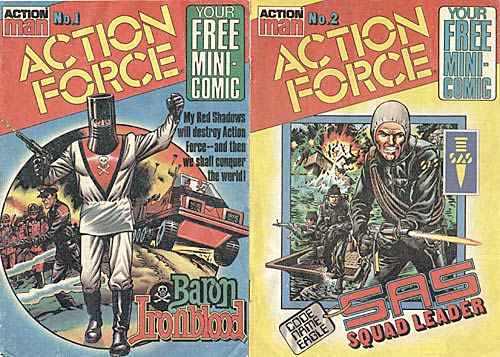
Action Force was given equal billing with the comics title and many die hard fans were angered by this especially as some regular strips in Battle had to end to make way for the toyline’s adventures. Despite the obvious commercialism the creators did their best with the source material and some of the tales were entertaining (I always found it funny that you could tell who was going to be killed in a storyline as it was always those characters who didn’t have a figure based on them), but many felt the overall quality of the comic changed for the worst.
Eventually the toyline reverted to simply importing and repackaging the regular GI Joe toys and ceased production on the UK line. The comic followed suit and to maintain continuity ran a story where Ironblood betrays his own forces, allowing them to be destroyed and goes into hiding, discarding his Ironblood persona and re-emerging as Cobra Commander. Although necessitated for commercial reasons the story of Cobra Commander recruiting his familiar henchmen and building Cobra was pretty enjoyable (later stories where Ironblood’s former agents and surviving Red Shadows returned for revenge on Cobra also provided some fun).
However the tie in still probably lost Battle some of it’s fans and when Marvel UK acquired the rights to produce Action Force’s comics at the end of 1986, the fans of Action Force deserted the comic too. Battle’s creation of a copycat Storm Force reeked of desperation and the comic’s days were numbered as it struggled along during the fall of the comics market until it was merged into Eagle in 1988.
While today Battle is a name on the comic wall of remembrance it’s legacy lives on in the reprint market as stories such as Darkie’s Mob, Johnny Red, Ratpack and of course Charley’s War are available as graphic novels. A number of books have been printed featuring the “best of” battle, as well as collections of artwork and covers from the comic.
Similarly as Commando continues to appear on newsagents shelves, collections can also be found in bookshops with a series of compilations.
War comics are a genre with a great deal of diversity and potential creativity. They can be can be simplistically action orientated, rallying cries of patriotism, used as propaganda or as tool to protest or inform (American underground comics excelled at this, especially during the Vietnam era which is a whole article in itself). They are able to show us humanity at it’s worst or conversely depict the goodness that can shine through during the very darkest of times.
When at their very best war comics can act as a warning. Of what the consequences are when countries embark on the very worst course of action no matter the cause. Because unlike with science fiction and superheroes, pretty much every scene that’s inked on the pages of a war comic happened to a living breathing person somewhere.

Til next Time,
Dazza


